by Dorothea Burstyn
if you like this page, support ASCAS clicking on the +1 button of google
(click on photos to enlarge image)
EXHIBITION: FABULOUS FLATWARE – NON-TRADITIONAL TOOLS OF
THE TABLE
The William P. Hood Jr. collection of contemporary flatware
The opening party of the exhibition Fabulous
Flatware - Non-traditional Tools of the Table at
the Paul and Lulu Hilliard University Art Museum,
Lafayette, Louisiana, on August 19, 2011, was a
glittering affair sponsored by the eminent Gorham
Martelé collectors Jolie and Robert Shelton of
Lafayette and attended by many donors to and members
of the Hilliard and the New Orleans Museum of Art.
|
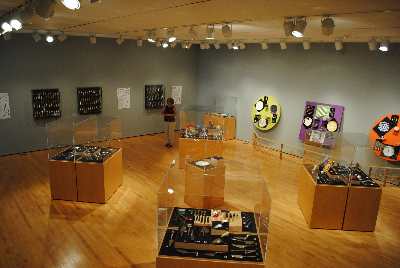
Main exhibition hall
|
The exhibition showcases part of Dr. William P.
Hood Jr.'s large collection of contemporary flatware
and traces the evolution of flatware from
traditional to non-traditional, from the late
nineteenth century to the early twenty-first. Dr.
Lee A. Gray, the show‘s curator, says the mission is
to show that good design can elevate relatively
mundane objects like forks, spoons, and knives to an
art form. She stresses that "good design is an
invisible luxury," often not even noticed but surely
able to make our lives much better. She deeply
appreciated the help and guidance of Dr. Hood. A
longtime expert on silver flatware of the second
half of the nineteenth century, an era where
flatware was produced in an almost endless and
fascinating variety of functional pieces and
patterns, Dr. Hood has contributed greatly to our
knowledge with innumerable well-researched magazine
articles and with his book Tiffany Silver
Flatware, 1845-1905: When Dining was an Art,
published in 2000 by Antique Collectors’ Club,
Suffolk, and reprinted in 2003. A few years ago Dr.
Hood shifted his collecting interest to contemporary
flatware and has built up a vast comprehensive
collection in record time. Selecting what should be
shown in the exhibition presented the biggest
challenge. In the end 330 basic place pieces from
110 patterns produced worldwide were chosen as the
core. These are complemented by many servers,
novelties, and miscellaneous implements, bringing
the total in the show to over 750 pieces of flatware.
|
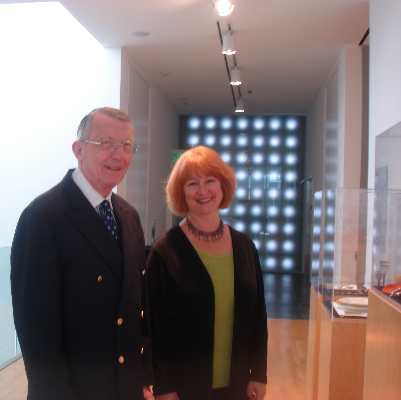
Dr. Lee Gray and Dr. William P. Hood
|
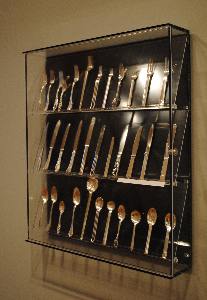
Unusual wall cases allow for better
comparison of flatware patterns
|
The core flatware is housed in cleverly designed
Plexiglass wall cases that display a fork, knife and
spoon in each pattern in a vertical array. Laid side
by side, these arrays form a top row of forks,
middle row of knives, and bottom row of spoons,
facilitating comparison of characteristics among the
piece types and patterns. The patterns to show
changes in decorative style are chronologically
organized. This allows the viewer to see the
striking contrast among designs created around the
same time, as for instance between Labors of
Cupid and Love Disarmed, both American
Art Nouveau designs of the early twentieth century,
and ultra-modern sets designed by Charles Rennie
Mackintosh of Scotland and Josef Hoffman of Austria.
Another case features Italian examples such as
Domus by Gio Ponti, representatives of the
Scandinavian Modern style like Odin and
Fjord among many others, and even shows Raymond
Loewy's inflight flatware for the Air France
Concorde SST. The case on Modernism and Beyond
introduces us to many exotic designs such as
Esotismo by Jean Marie Patois, 1988, where the
various piece types take the form of animals (the
knife is a crocodile, the fork is a bird and the
spoon a fish); TI-1, a Japanese pattern which
features a unique serrated circular knife blade;
mono-tools, a modern German take on the possible
shape of prehistoric eating tools; and Robert
Venturi, named after its architect-designer,
which is a return to figural forms, intentionally
abandoning the stark international Style by
declaring "less is a bore".
|
Other wall cases examine the changes over time
in terms of size and form, functional types,
designers and producers, and materials and
techniques. Flatware has become much smaller over
the decades. New functional types have been
developed, including amuse-bouche spoons, gourmet/sauce
spoons, spaghetti forks, combination pieces such as
sporks (spoon/fork) and even special tools to eat
avant-garde forms of foods such as "foam". Sometimes
the innovative can border on the absurd, as in the
case of Fritz & Frieda, introduced in 2007 by
Carl Mertens, which is a pair of picks for French
fries, sausages, etc., that can double as tiepins;
or the Clothespin spoon, a unique concoction
equipped with a clip for holding a herb or flower to
allow enjoyment of different aromas while eating.
|
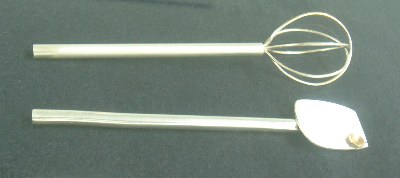
Tools for eating foams, the avant-garde food
forms created by chef Ferran Adrià in Spain,
hand-made in sterling silver and copper, by
Canadian silversmith Anne Barros, 2010
|
At the beginning of the twentieth century important silver
manufacturers still had a large in-house design staff, while
today’s flatware producers rely largely on outsourcing. Legion
are the patterns designed by important male architects. This
goes along with Dr. Hood's statement that flatware-collecting is
a male-dominated hobby based on mens' fascination with tools.
Myriad items are also influenced by prominent chefs, who
encourage the creation of new implements for their innovative
foods.
While traditional flatware was either solid silver or
silver-plate, prevailing lifestyle changes of working women and
households without servants resulted in the predominance of the
easy-to-take-care-of stainless steel flatware in today’s market
place. Stainless steel has been combined with many different
materials to introduce color and texture, such as plastic, wood,
porcelain, pewter, pate-de-verre and colored nylon. Some
chemical processes achieve the same effect – as for instance
with anodized aluminum or carbon-coated steel– but are also used
to give flatware a scratch-resistant or stain/corrosion-resistant
finish. It is surprising that argentium silver, a
tarnish-resistant silver alloy so popular in the jewelry
industry, has not met with more acceptance for flatware
production. The only flatware example produced to date,
Chameleon, handmade by silversmith Cynthia Eid in 2004, is
in the show. Here the big American silver manufacturers of the
late nineteenth century like Gorham and Tiffany, who took on
huge financial risks to introduce novel materials and objects,
are sorely missed. An extra-hard plastic Lexan was used for
Design Ten (1981) by Don Wallance. Credit card cutlery,
produced in Holland since 2006, features a snap-out plastic
miniaturized fork and knife/spatula in a credit card-size case.
For the environmentally conscious, Pandora Design even produces
the disposable hors d’oeuvre sporks Moscardino, designed
by Giulio Lacchetti and Matteo Ragni, and made from a
biodegradable starch-based polymer.
The floor cases are a lot of fun because they group flatware
pieces thematically. Espresso, anyone? shows mocha cups
of unusual and futuristic designs next to an array of small
spoons, all of which I would like to take home. Adorable is the
selection of children’s flatware- Eating Can be Fun. These
are not miniature adult sets for the modern child but fun pieces
in cheerful colors with handles shaped as animals, cartoon
characters and even bulldozers. A child's fork is a play on Air
Force One, the President’s airplane, Airfork One "will
bring those peas and mashed potatoes in for a safe landing",
according to its American producer Fred & Friends. Lovingly
Handmade shows the beautiful and exact workmanship of
contemporary silversmiths. Here it is brought home to us that no
uniform contemporary style seems to exist, Trussware and
Table Tools, the very technical-looking silverware made
by Boris Bally, are shown next to very Shiebler-looking servers
in the form of nasturtium and maple leaves, designed and
handmade by American silversmith Robyn Nichols. Additional
pedestal cases show a dizzying array of flatware used for
traveling, eating pizza and pasta, and serving salad and cake/pastry.
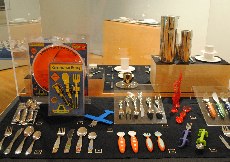
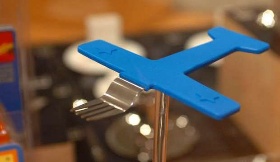
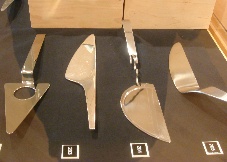
|
Floor case "Eating can be fun"
Air Fork One
Various cake servers
|
Other floor cases feature table settings with spectacular
dinnerware, glassware and linens complementing the flatware.
These range from the ultra-elegant Attelage by Hermès and
Nobel, designed by Gunnar Cyrén and used since 1991 at the
awards dinner in Stockholm, to the funky Boneware by
Michael Aram, a US designer who works and lives in India.
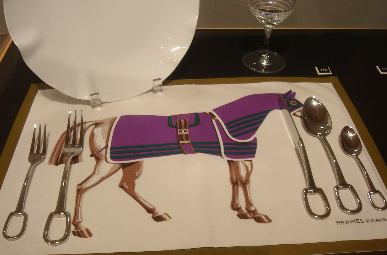
Attelage by Hermès,
introduced 1997
|
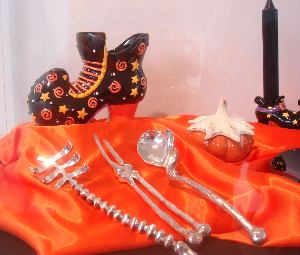
Boneware, designed 1995
by Michael Aram, combined with Vietri pumpkin soup
bowl/lid
|
As the Hilliard Museum is associated with the
University of Louisiana, Dr. Lee Gray involved many
students of its various design departments with the
exhibition. Architecture students helped create the
vertically oriented big round table tops in daring
colors, which give the exhibition extra "zip".
Hailey Boudreaux, UL graphic design student,
produced the visually pleasing wall panels and a
smart looking catalogue. The text of the wall panels
gives an introduction to the various displays. The
catalogue is not only a list of all items shown but
also a treasure trove of data on designers and
producers and of background information. Both are
the work of Dr. Hood, who gave a lecture on August
20, imparting additional knowledge about the
development of contemporary flatware design and
production. This was very well attended and received
and made many a listener into a modern flatware fan.
|
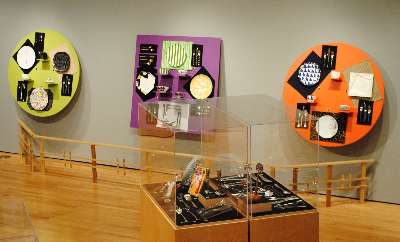
Vertical big round table tops
|
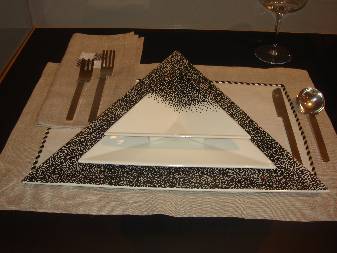
Russel
Wright flatware, designed 1933,
introduced commercially late 1980s
|
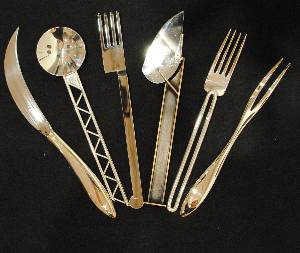
A selection of modern
flatware, from left to right, Arpège vegetable knife,
Christofle 2005, designed by Alain Passard, chef and
owner of L’Arpège Restaurant., Trussware dinner
spoon, designed 1903, executed in sterling silver by
Boris Bally, 2001, XUM dinner fork, designed by
Robert Wilhite, 1990,Table Tools table knife,
designed and handmade in sterling silver by Boris
Bally, 2001, Arpège vegetable fork.
|
The exhibition can be visited until December 17. 2011, at the Hilliard Museum. After that it
will travel to museums in Alabama: Dothan, Montgomery and Mobile. As previously mentioned, the
shown items represent only the "tip of the iceberg" of a truly remarkable collection.
I hope that the appetite for this kind of venue is whetted now and that lovers of contemporary
flatware can expect even bigger things to come.
Dorothea Burstyn is the Editor of the Silver Society
of Canada Journal
and Administrator of SSC website
http://www.silversocietyofcanada.ca
- 2011 -
|
|
|

